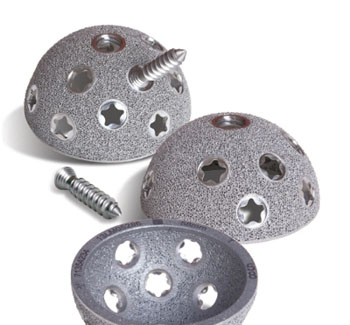3D-Printed Titanium Implant Advances Hip Revision Surgery
By HospiMedica International staff writers
Posted on 20 Mar 2016
An innovative, entirely porous implant mimics the structure of natural cancellous bone, allowing bone ingrowth to secure the implant in place.Posted on 20 Mar 2016
The REDAPT revision acetabular fully porous cup is designed for revision cases where compromised bone makes implant fixation and stability more difficult, thus requiring the use of an uncemented cup that allows bone ingrowth. To allow that ingrowth, an additive titanium manufacturing process is used to produce an alternative to external porous coatings, such as the sintered beads or fiber mesh used in other uncemented implants. The additive process results in an entirely porous implant that mimics the natural architecture of human bone.

Image: The REDAPT Revision Acetabular Fully Porous Cup (Photo courtesy of Smith & Nephew).
The cup is also supplied for use with new variable-angle locking screws that can be used to enhance implant stability and minimize micro-motion after surgery. The screws work within the implant’s unique geometry to provide both compression and a rigid construct to the acetabular shell. The cup can also be used with traditional, non-locking screws. The REDAPT revision acetabular fully porous cup is a product of Smith & Nephew (London, United Kingdom), and has been approved by the US Food and Drug Administration (FDA).
“We’re excited about the creative possibilities this new manufacturing process holds for surgeons and their patients,” said Mike Donoghue, vice president of global reconstruction at Smith & Nephew. “Bringing to market a 3D-printed titanium acetabular cup for difficult revision procedures is just one example of the potential of this remarkable technology.”
“This fully porous cup gives surgeons flexibility in ways that simply weren’t possible before. This cup builds on good technology and turns it into something spectacular,” said orthopedic surgeon Prof. Craig Della Valle, MD, of Rush University Medical Center (Chicago, IL, USA), who participated in the surgeon design team of the new REDAPT cup. “The locking screws, screw-in trials, purpose-built liners and screw hole patterns optimized for hard-to-access areas really set it apart during a revision procedure.”
The CONCELOC technology used to build the REDAPT Cup begins by precisely aiming a laser onto a thin layer of titanium (Ti-6Al-4V) powder. The heat generated by the laser fuses the powder together, layer-by-layer, until a fully formed titanium construct is produced. The manufacturing process allows for complex design geometries that would be difficult, expensive, or impossible to achieve with traditional manufacturing methods. For example, solid reinforcements can be built directly into the porous structure to provide extra strength in precise locations.
Related Links:
Smith & Nephew














